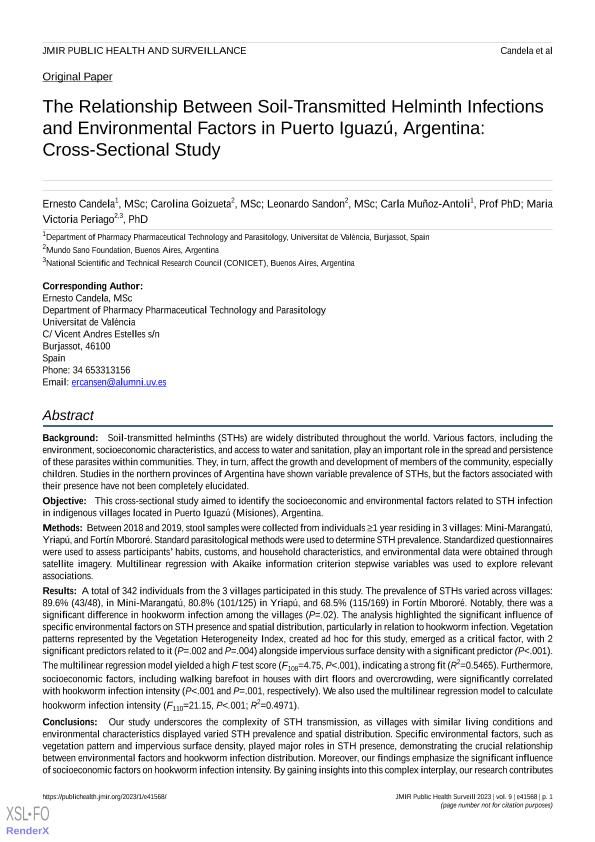Artículo
Cross-sectional study to determine the relationship between soil-transmitted helminth infections and environmental factors in Puerto Iguazú, Misiones (Argentina) (Preprint)
Candela, Ernesto; Goizueta, Carolina; Sandon, Leonardo; Muñoz Antoli, Carla; Periago, Maria Victoria

Fecha de publicación:
07/2022
Editorial:
JMIR Publications
Revista:
JMIR Public Health and Surveillance
e-ISSN:
2369-2960
Idioma:
Inglés
Tipo de recurso:
Artículo publicado
Clasificación temática:
Resumen
Background: Soil-transmitted helminths (STHs) are widely distributed throughout the world. Various factors, including the environment, socioeconomic characteristics, and access to water and sanitation, play an important role in the spread and persistence of these parasites within communities. They, in turn, affect the growth and development of members of the community, especially children. Studies in the northern provinces of Argentina have shown variable prevalence of STHs, but the factors associated with their presence have not been completely elucidated. Objective: This cross-sectional study aimed to identify the socioeconomic and environmental factors related to STH infection in indigenous villages located in Puerto Iguazú (Misiones), Argentina. Methods: Between 2018 and 2019, stool samples were collected from individuals ≥1 year residing in 3 villages: Mini-Marangatú, Yriapú, and Fortín Mbororé. Standard parasitological methods were used to determine STH prevalence. Standardized questionnaires were used to assess participants’ habits, customs, and household characteristics, and environmental data were obtained through satellite imagery. Multilinear regression with Akaike information criterion stepwise variables was used to explore relevant associations. Results: A total of 342 individuals from the 3 villages participated in this study. The prevalence of STHs varied across villages: 89.6% (43/48), in Mini-Marangatú, 80.8% (101/125) in Yriapú, and 68.5% (115/169) in Fortín Mbororé. Notably, there was a significant difference in hookworm infection among the villages (P=.02). The analysis highlighted the significant influence of specific environmental factors on STH presence and spatial distribution, particularly in relation to hookworm infection. Vegetation patterns represented by the Vegetation Heterogeneity Index, created ad hoc for this study, emerged as a critical factor, with 2 significant predictors related to it (P=.002 and P=.004) alongside impervious surface density with a significant predictor (P<.001). The multilinear regression model yielded a high F test score (F108=4.75, P<.001), indicating a strong fit (R2=0.5465). Furthermore, socioeconomic factors, including walking barefoot in houses with dirt floors and overcrowding, were significantly correlated with hookworm infection intensity (P<.001 and P=.001, respectively). We also used the multilinear regression model to calculate hookworm infection intensity (F110=21.15, P<.001; R2=0.4971). Conclusions: Our study underscores the complexity of STH transmission, as villages with similar living conditions and environmental characteristics displayed varied STH prevalence and spatial distribution. Specific environmental factors, such as vegetation pattern and impervious surface density, played major roles in STH presence, demonstrating the crucial relationship between environmental factors and hookworm infection distribution. Moreover, our findings emphasize the significant influence of socioeconomic factors on hookworm infection intensity. By gaining insights into this complex interplay, our research contributes to a better understanding of STH transmission characteristics, thereby informing targeted public health interventions for effective control.
Archivos asociados
Licencia
Identificadores
Colecciones
Articulos(SEDE CENTRAL)
Articulos de SEDE CENTRAL
Articulos de SEDE CENTRAL
Citación
Candela, Ernesto; Goizueta, Carolina; Sandon, Leonardo; Muñoz Antoli, Carla; Periago, Maria Victoria; Cross-sectional study to determine the relationship between soil-transmitted helminth infections and environmental factors in Puerto Iguazú, Misiones (Argentina) (Preprint); JMIR Publications; JMIR Public Health and Surveillance; 9; 7-2022; 1-14
Compartir
Altmétricas



